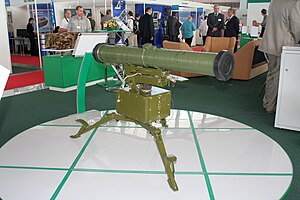Skif (ATGM)
| Skif | |
|---|---|
 A Skif on a tripod. | |
| Type | ATGM |
| Place of origin | Ukraine |
| Service history | |
| In service | 2011-present [1] |
| Used by | See Users |
| Production history | |
| Designer | "Luch" State Kyiv Design Bureau |
| Variants | See Variants |
| Specifications | |
| Mass | 676 lb |
| Diameter | 130/155 mm |
Detonation mechanism | Impact fuze |
Operational range |
|
Guidance system | SACLOS laser beam riding with target tracking in TV or thermal imaging channels in manual or auto mode [2] |
Launch platform | Tripod, vehicle mount on remote weapon station (RWS) |
The Skif is a Ukrainian anti-tank guided missile (ATGM) system developed by the Luch Design Bureau.[2][1][3] Its guidance device (ПН-С) is developed and manufactured by Belarusian design bureau Peleng based in Minsk.[4] The name literally means "Scythian".
The Skif is designed to destroy modern armored targets with combined carried or monolithic armor including explosive reactive armor (ERA). Skifs can attack both stationary and moving targets. They can attack from both far range (up to 5km in the daytime) and close range (100m). They can attack pinpoint targets like weapon emplacements, lightly armored objects, and hovering helicopters. In addition to manual operation, the Skif has an automated fire and forget targeting mode that does not require manual tracking of the target.[2][5] In 2018, an upgraded export variant of the Skif was tested by the Ukrainian military.[6]
Design[]
The Skif consists of a tripod, missile container, PDU-215 remote control panel, guidance device and thermal imager.[2][1]
The PDU-215 control panel is a briefcase-like laptop with a control panel, containing a small joystick and a flat-screen display to assist the missile’s guidance. Two firing modes are available: manual, and fire-and-forget. Fire-and-forget provides automatic control of the missile flight using a targeting laser beam. The PDU-215 allows the control of the unit from up to 50 meters away (with a wire channel).[1]
A three to four-person team is optimal for deploying the Skif, operators require specially-made backpacks. Once the missile is fired, the operator controls the Skif and corrects the aim when necessary, by using the joystick on the remote control. The Skif's system has a shelf life of 15 years. The missiles have a 10-year shelf life.
The system comes complete with 130mm and 152mm caliber missiles in transport and launching containers. Tandem charge HEAT RK-2S warheads might be able to counter medium weight main battle tanks such as the T-90A with penetration of 800mm behind ERA. RK-2M-K warheads might be able to counter heavy main battle tanks such as M1 Abrams with their penetration of 1100mm behind ERA. The system also includes HE-fragmentation RK-2OF and RK-2М-OF warheads to attack infantry positions and light armored vehicles. The system can use all four types of missiles without requiring modification. The system has a thermal imager for use during night operations.[2][1]
Variants[]
The system has four types of missiles in two different calibers.[2][1]
130mm Missiles[]
130mm missiles with RK-2S and RK-2OF warheads:
- Missile caliber: 130mm
- Firing range (day): 100m - 5km
- Firing range (night): 100m - 3km
- Full system weight: 97kg[3]
- Missile in container weight: 30kg
- Warhead penetration:
- RK-2S Tandem-charge HEAT: Not less than 800mm behind ERA
- RK-2OF HE-fragmentation: Not less than 60mm with ≥ 600 fragments
- Container length: 1360mm
152mm Missiles[]
152mm missiles with RK-2M-K and RK-2М-OF warheads:
- Missile caliber: 152mm
- Firing range (Day): 100m - 5.5km
- Firing range (Night): 100m - 3km
- Full system weight: 104kg[3]
- Missile in container weight: 37kg
- Warhead Penetration:
- RK-2M-K Tandem-charge HEAT: Not less than 1100mm behind ERA
- RK-2М-OF HE-fragmentation: Not less than 120mm with ≥ 1000 fragments
- Container length: 1435mm
SERDAR[]
SERDAR is a stabilized remote controlled weapon station (RCWS). The system was jointly developed by the Luch Design Bureau, Turkish company Aselsan Spets, and Techno Export, part of Ukraine’s Ukroboronprom enterprise. The system carries two (in some versions four) 130mm or 155mm missiles with RK-2S or RK-2M-K tandem-charge HEAT warheads. The system is also equipped with 12.7mm and 7.62mm caliber machine guns.[7] A joint company for the production of Skif missiles was established in Turkey and production began in early 2020.[1]
Shershen[]
Shershen is a Belarusian ATGM based on Skif. It also has different types of 130mm and 152mm missiles.[8]
Users[]
See also[]
References[]
- ^ a b c d e f g h "Skif Anti-Tank Guided Missile | Military-Today.com". www.military-today.com. Archived from the original on 2017-07-08. Retrieved 2018-03-23.
- ^ a b c d e f ""SKIF" man portable antitank missile system". www.luch.kiev.ua. Archived from the original on 2017-12-10. Retrieved 2018-03-23.
- ^ a b c "LUCH,State Keiv Design Bureau" (PDF). State Keiv Design Bureau,LUCH. Retrieved 1 November 2020.
- ^ "ЦАМТО / Главное / Украина рассчитывает на увеличение экспортных поставок ПТРК "Скиф"". armstrade.org.
- ^ "Skif – Trojan". Archived from the original on 2018-03-25. Retrieved 2018-03-24.
- ^ "Ukraine Tests New Anti-tank Guided Missile System 'Skif'". www.defenseworld.net. Retrieved 2021-04-04.
- ^ "Ukrainian-Turkish SERDAR Anti-Tank Missile Launching System Passes Qualifying Trials". DEFPOST. Retrieved 1 November 2020.
- ^ "Shershen". Military Today. Retrieved 1 November 2020.
- ^ "Algerian army acquired the Skif ATGM from Ukraine". Menadefense.net. Retrieved 27 July 2016.
- ^ "More Ukrainian missiles Corsar and Skif and their portable anti-armor platforms for Saudi Arabia". Pakistan Defence. Retrieved 2021-05-25.
- ^ "SIPRI Trade Register". Stockholm International Peace Research Institute.
- ^ "روسيا تتوجه لاحالة SU-24MR على التقاعد و استبدالها بدرونات Orion و Altius". Defense Arab المنتدى العربي للدفاع والتسليح.
- Anti-tank missiles of Ukraine
- Military equipment introduced in the 2010s
- Fire-and-forget weapons